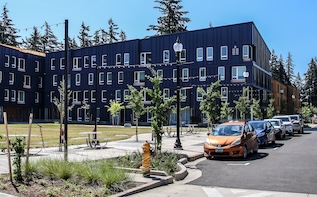- Home
- Urban Design and Planning
- Handouts, Applications and Forms
Urban Design and Planning
Planning Handouts, Applications and Forms
The following is a list of common application types and links to information for each. If you don't see the application type you are looking for on this list, or have additional questions, please contact the Planner on Duty at 503-618-2780 or POD@GreshamOregon.gov.
The primary code section is included with each application type below. However, the review of land use applications includes all applicable sections of the Development Code.
The City recently updated its fees. While we are in the process of updating handouts to reflect those changes, please refer to the master fee schedule for current fees.
A design review examines most multi-family and townhome residential, commercial, industrial, or institutional development to make sure it meets the design criteria of the Gresham Community Development Code (GCDC). Design rules are specific to each project's location and the type of development proposed. Applicants seeking to receive early guidance and direction from the Design Commission may apply for an Optional Early Assistance Design Advice and/or a Design Commission Consult.
Design Commission - Early assistance design advice/Design Commission consult
Design Review A for simple conversions
Development Code Section 4.1100 - Downtown Plan District
Development Code Section 4.1200 - Civic Neighborhood Plan District
Development Code Section 7.0100 - Multi-Family Design Guidelines and Standards
Development Code Section 7.0500 - Rockwood Design Guidelines and Standards
Development Code Section 7.0600 - Commercial Design Guidelines and Standards
For a Design Review D and Design Review E, a detailed checklist specific to your project will be provided by City staff after the required pre-application conference.
Middle Housing includes duplexes, triplexes, quadplexes, townhouses, and cottage clusters. Middle Housing can be developed on properties zoned for single detached dwellings through a building permit.
Middle Housing Land Divisions (MHLDs) allow lots developed under Middle Housing standards to be divided without needing to meet the stricter standards of a traditional Land Division. A MHLD application can be submitted at the same time or after a Middle Housing building permit application is submitted.
An accessory dwelling unit (ADU) is a secondary unit on a single family residential property. It functions as a complete, independent living space with a separate kitchen, bathroom, and sleeping area.
Accessory dwelling unit information and application
Development Code Section 10.0100 - Accessory Dwellings
Contact
For more information about accessory dwellings contact the Planner on Duty at 503-618-2780 or POD@GreshamOregon.gov.
Trees in Gresham are regulated differently depending on their location, purpose, size, and type.
Regulated trees are those greater than 8-inches in diameter at breast height (DBH). Three regulated trees not in an environmental district and not qualified as required or significant, can be removed in a 12-month period through the exemption process. Removal of more than the exempted number of trees will need to go through a Type II process.
Required trees are those subject to specific standards for removal and replacement and include street trees, buffer trees, perimeter trees, landscape trees, and parking lot trees. These trees generally must be replaced and can only be removed through the Type I process. Additional information may be required regarding the reason for removal.
Significant trees are those designated by the City as having unique importance.
Trees are subject to specific standards for removal and replacement when they are in environmentally sensitive areas, such as those in the floodplain, hillside, and habitat conservation areas. These trees can generally only be removed if they are hazardous and their removal will need to be mitigated. When replacement is required, an affidavit and photograph will be submitted to the City within 6 months of removal.
A food and beverage cart is a mobile non-motorized unit that sells mostly food and/or drinks. If a cart will be on site for less than four hours, it does not need a permit.
For more information visit the food and beverage cart page.
A land division involves dividing land to create additional lots or parcels.
A lot line adjustment and/or lot consolidation involves no new lots being created. Instead, lot lines are moved, removed, or adjusted to change the configurations of existing properties.
Lot line adjustments and lot consolidations
Development Code Section 6.0000 - Introductory Provisions
Development Code Section 6.0100 - Lot Line Adjustments and Lot Consolidations
Development Code Section 6.0200 - Partitions and Subdivisions
Development Code Section 6.0300 - Planned Developments
Development Code Section 6.0400 - Land Division Final Plat Requirements
A Special Use Review provides a way to evaluate uses that may be compatible in an underlying land use district, provide helpful services, and serve important public interests, but require case-by-case review.
Certain types of work do not require a planning permit.
- Internal changes to buildings unless they change the use of a building or otherwise require design review
- An emergency measure necessary for the immediate safety of persons or protection of property (permits will be required retroactively unless listed here)
- Wireless communication facilities in the right-of-way
Minor floodplain development requires a Type I floodplain permit.
- Construction, maintenance or demolition of storage sheds and other accessory structures otherwise exempt from a building permit
- Fences
- Tree removal
- Erection of a tent
- Expansion of an existing farming operation
- An alteration that does not substantially affect the use of appearance of land or a structure
- A helicopter landing facility for emergency service
- Temporary construction offices
- Minor basic utilities and public facilities
- Excavation of filling of land not exceeding 50 cubic yards within any one year period.
Other development requires a Type II Permit and the process will begin with a pre-application conference.
Development Code Section 5.0100 Flood Plain Overlay District
Temporary, intermittent, and interim uses are allowed depending on zoning of the proposed use site. The following documents are common types of temporary use permits.
Christmas tree sales and firework sales
Lodging and warming/cooling shelters
Temporary buildings and dwellings
Temporary signs are allowed without a permit but are still subject to development code.
A home occupation is a business or commercial activity conducted within a dwelling unit by the permanent residents where the primary use is for living purposes. A Type I home occupation may be possible if there are no employees or customers coming to the site. All other home occupations will need to be reviewed as a Type II.
For more information, visit the home-based businesses page.
When a lot was not created through the partition or subdivision process, a land use review is needed before a single-family home can be constructed. The review is focused on making sure the lot was created legally and the house can adequately be served with water, sewer, storm, street, and emergency services.
The purpose of a zoning verification letter is to confirm in writing the allowed uses, development standards, and regulations applicable to a specific site. Zoning verification letters can be requested by anyone at any time.





